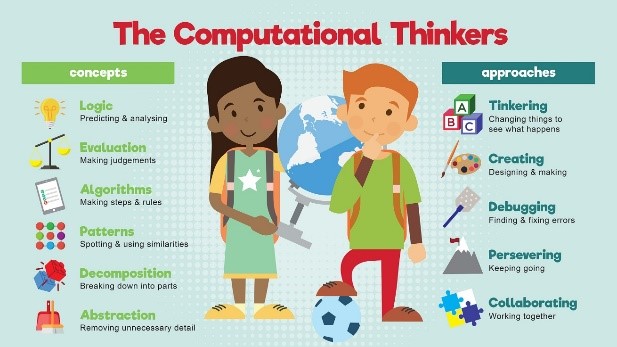
Computational Thinking Skills: Image Source: Osmo: Teaching Computational Thinking to Kids
During the next few weeks, we will be practicing the use of terminology specific to computer science that can be used across many subject areas. Practice and get to the habit of using it when possible.
Algorithm - Procedure for solving a problem. Set of steps and rules needed to achieve the same desired outcome every time. In a computer world, it is a computer thought process.
Branching - Executing a different instruction sequence based on data. The most common programming statement used to branch is the "IF" "then" statement, or yes no
Coding - Coding is a method of communicating with a computer.
Code - a language that programmers create and use to tell a computer what to do https://www.youtube.com/watch?v=9LVbhM2VHiY
Computational Thinking (CT) - a problem-solving process involving expressing solutions as computational steps or algorithms that a computer (and humans) can solve or implement. Computational Thinking explained with the visuals (slideshow)
Debugging - A bug is a flaw or glitch in a system- debugging is a process of finding the error. It may teach students resiliency. How to fix the problem?
Decomposition - breaking down problems into smaller, more manageable pieces. It can be a powerful problem-solving technique that gives students skills to solve complex problems.
Exact instructions - writing down the precise instructions to be followed to complete a task. (challenge created by Josh Darnit to teach students that computers cannot make mental leaps and assume what is omitted in the instructions).
Flowchart- Flowchart is a type of diagram that represents a workflow or process (a graphical representation of an algorithm).
Loops - (iteration, repetition) allows code to be executed repeatedly. Iteration can change the project flow by repeating a behavior a specified number of times or until a condition is met.
Scaffolding - method in which teachers break up learning into smaller, increasingly complex steps and guide students as they learn and develop a new concept or skill. The activities progressively move students toward greater independence and understanding.
Sequence - the instructions are presented in the specific correct order
Variable - something that can change - like a temperature - a thermometer will cool or heat depending on the temp variable.

Computational Thinking Skills: Image Source: Osmo: Teaching Computational Thinking to Kids

Consider this simplified algorithm for dealing with potential problems. Follow the flowchart: Fix the things in your control and learn to live with those you can't.